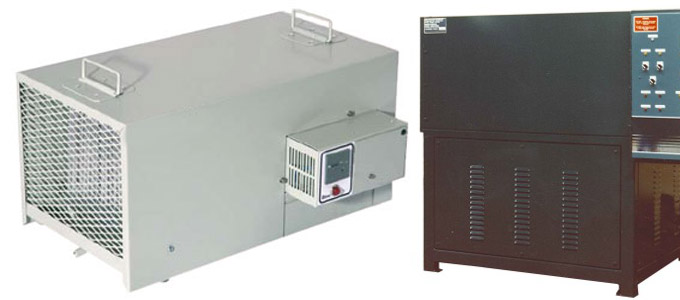Dehumidifiers

Dehumidification is the process of absorbing moisture from the atmospheric level and it is necessary in the various manufacturing, packing & Storage of variety of engineering & food products. In addition to comfort air conditioning. The resulting reduction of relative humidity helps to prevent rust & corrosion in engineering Industry, bacteria (fungus) formation in food processing industry as well as pharmaceutical products.
De-humidification is normally achieved either by passing air over a cooling coil whose surface temperature is less than the dew point temperature of air or by chemical absorption of moisture in the air.
A simple design of de-humidifier consists of a compressor, finned condenser and cooling coil, capillary, air circulating fan with motor, cabinet to house components & means to dispose off the condense. The physical construction of the system is almost similar to that of window air – conditioner.
The moist room air is drawn through the cooling coil / evaporator & cooled to a temperature below its dew point thus removing the moisture which is drained off. The cooled air is then allowed to pass over the condenser (also known as reheat coil) where the air is heated sensibly and discharged into the room at a higher temperature but at a lower relative humidity. This being a continuous cycle the relative humidity in the room is gradually lowered to the desired level, which is controlled by a electronic digital RH controller.
Introduction to the process of De-humidification.
Why Dehumidification?
Corrosion
Iron & steel will not rust if the air in contact with the surface has a relative humidity below 50%. Dehumidification is often a better & less expensive way to protect investments than painting the objects that are protected by dehumidification.
Condensation:
Moisture will not condensate on a surface if the air in contact with it has a dew point lower than the surface temperature. Condensation can lead to many problem such as corrosion or short circuit in electrical systems.
ICE Formation:
Ice will not form on a surface if the air in contact with it has a dew point lower than the surface temperature. Ice formation is a problem in for example cold storages where it will cause a lower efficiency in the cooling machinery. Dehumidification will keep the Ice away.
MOULD:
Mould & fungus formation is prevented if the surrounding air is kept below 70% RH. This is important in many situations for e.g., in storage of wooden products, in houses, designed with a crawl space it is often necessary to use a dehumidifier to keep mould and fungus from formatting.
Bacteria:
Bacteria need humidity required for bacteria to multiply is found on hygroscope materials. If the surrounding air is held below 50% RH most bacteria will not find a suitable environment to multiply.
Odours:
Bad smell will drastically be reduces if the RH is kept below 50%. For e.g., Sewage Stations the odour can often be controlled by installing a dehumidifier. Dehumidification is an on going process to reduce and keep the air moisture low at an enclosed space.





